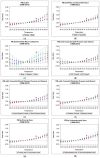Susceptibility to Heat-Related Fluid and Electrolyte Imbalance Emergency Department Visits in Atlanta, Georgia, USA
- PMID: 27706089
- PMCID: PMC5086721
- DOI: 10.3390/ijerph13100982
Susceptibility to Heat-Related Fluid and Electrolyte Imbalance Emergency Department Visits in Atlanta, Georgia, USA
Abstract
Identification of populations susceptible to heat effects is critical for targeted prevention and more accurate risk assessment. Fluid and electrolyte imbalance (FEI) may provide an objective indicator of heat morbidity. Data on daily ambient temperature and FEI emergency department (ED) visits were collected in Atlanta, Georgia, USA during 1993-2012. Associations of warm-season same-day temperatures and FEI ED visits were estimated using Poisson generalized linear models. Analyses explored associations between FEI ED visits and various temperature metrics (maximum, minimum, average, and diurnal change in ambient temperature, apparent temperature, and heat index) modeled using linear, quadratic, and cubic terms to allow for non-linear associations. Effect modification by potential determinants of heat susceptibility (sex; race; comorbid congestive heart failure, kidney disease, and diabetes; and neighborhood poverty and education levels) was assessed via stratification. Higher warm-season ambient temperature was significantly associated with FEI ED visits, regardless of temperature metric used. Stratified analyses suggested heat-related risks for all populations, but particularly for males. This work highlights the utility of FEI as an indicator of heat morbidity, the health threat posed by warm-season temperatures, and the importance of considering susceptible populations in heat-health research.
Keywords: climate change; emergency department visits; fluid and electrolyte imbalance; heat morbidity; temperature.
Conflict of interest statement
The authors declare no conflict of interest. The founding sponsors had no role in the design of the study; in the collection, analyses, or interpretation of data; in the writing of the manuscript, and in the decision to publish the results.
Figures



Similar articles
-
Warm season temperatures and emergency department visits in Atlanta, Georgia.Environ Res. 2016 May;147:314-23. doi: 10.1016/j.envres.2016.02.022. Epub 2016 Feb 27. Environ Res. 2016. PMID: 26922412 Free PMC article.
-
Evaluation of individual and area-level factors as modifiers of the association between warm-season temperature and pediatric asthma morbidity in Atlanta, GA.Environ Res. 2017 Jul;156:132-144. doi: 10.1016/j.envres.2017.03.021. Epub 2017 Mar 22. Environ Res. 2017. PMID: 28342349 Free PMC article.
-
Time-series Analysis of Heat Waves and Emergency Department Visits in Atlanta, 1993 to 2012.Environ Health Perspect. 2017 May 31;125(5):057009. doi: 10.1289/EHP44. Environ Health Perspect. 2017. PMID: 28599264 Free PMC article.
-
Association of ambient extreme heat with pediatric morbidity: a scoping review.Int J Biometeorol. 2022 Aug;66(8):1683-1698. doi: 10.1007/s00484-022-02310-5. Epub 2022 Jun 25. Int J Biometeorol. 2022. PMID: 35751701 Free PMC article.
-
[Heat-related morbidity: real-time surveillance via rescue service operations data from the interdisciplinary care capacity proof system (IVENA)].Bundesgesundheitsblatt Gesundheitsforschung Gesundheitsschutz. 2019 May;62(5):589-598. doi: 10.1007/s00103-019-02938-6. Bundesgesundheitsblatt Gesundheitsforschung Gesundheitsschutz. 2019. PMID: 30989261 Review. German.
Cited by
-
Outdoor temperature and circulating sodium in children with acute gastroenteritis.Pediatr Res. 2022 Nov;92(5):1270-1273. doi: 10.1038/s41390-022-01947-7. Epub 2022 Feb 17. Pediatr Res. 2022. PMID: 35177815
-
The Impact of Climate Change and Extreme Weather Conditions on Cardiovascular Health and Acute Cardiovascular Diseases.J Clin Med. 2024 Jan 28;13(3):759. doi: 10.3390/jcm13030759. J Clin Med. 2024. PMID: 38337453 Free PMC article. Review.
-
Not so little differences: variation in hot weather risk to young children in New York City.Public Health. 2018 Aug;161:119-126. doi: 10.1016/j.puhe.2018.06.004. Epub 2018 Jun 28. Public Health. 2018. PMID: 29960726 Free PMC article.
-
Associations Between Temperature and Location of Injury or Condition Among Heat-Related Emergency Department Visits.Geohealth. 2025 Apr 14;9(4):e2024GH001287. doi: 10.1029/2024GH001287. eCollection 2025 Apr. Geohealth. 2025. PMID: 40231221 Free PMC article.
-
Extreme Heat and Arrhythmia in Patients With Implanted Devices.J Am Heart Assoc. 2025 Jun 17;14(12):e040352. doi: 10.1161/JAHA.124.040352. Epub 2025 Jun 5. J Am Heart Assoc. 2025. PMID: 40470645 Free PMC article.
References
-
- World Health Organization . Quantitative Risk Assessment of the Effects of Climate Change on Selected Causes of Death, 2030s and 2050s. World Health Organization; Geneva, Switzerland: 2014.
-
- Confalonieri U., Menne B., Akhtar R., Ebi K.L., Hauengue M., Kovats R.S., Revich B., Woodward A. Human health. In: Parry M.L., Canziani O.F., Palutikof J.P., van der Linden P.J., Hanson C.E., editors. Climate Change 2007: Impacts, Adaptation and Vulnerability. Contribution of Working Group II to the Fourth Assessment Report of the Intergovernmental Panel on Climate Change. Cambridge University Press; Cambridge, UK: 2007. pp. 391–431.
-
- U.S. Global Change Research Program . In: Climate Change Impacts in the United States: The Third National Climate Assessment. Melillo J.M., Richmond T.C., Yohe G.W., editors. U.S. Global Change Research Program; Washington, DC, USA: 2014. p. 841.
MeSH terms
Substances
Grants and funding
LinkOut - more resources
Full Text Sources
Other Literature Sources
Medical

